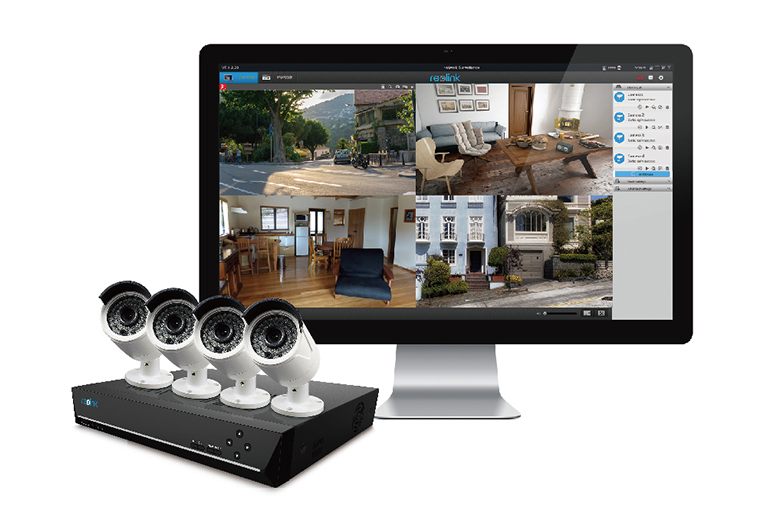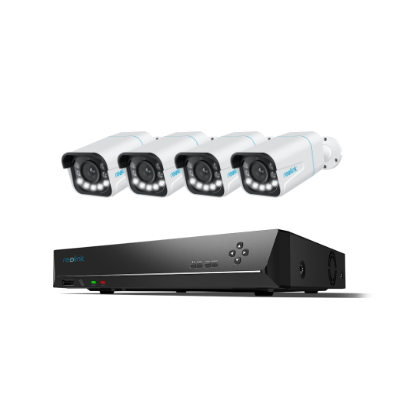Best Wired Security Camera Systems: 2026 The Ultimate Guide

In a wired security system, also known as a hardwired security system, every piece of equipment is connected through different cables. So what are the features of a wired security camera system? How can it be installed, and what should you consider when choosing the right wired security system?
In this guide, we'll dive into the best wired security camera systems of 2025, exploring their features, advantages, and why they remain a trusted option for home and business security.
What is the Best Wired Security Camera System?
The best wired security system has cameras transmitting signals and information to the central control panel or hub via cables. The transmitted signals are then viewed via a monitor or screen.

Components
- NVR/DVR: In a wired system, NVRs and DVRs are a central panel or "hub." They are the core of this system, not only because all the devices connect to them through cables but also because they store all the data and information.
- Camera: Cameras also play an essential role. The camera's primary function is recording videos, capturing footage, and transmitting all the data to the central panel.
- Monitor: You may need a monitor to review videos or photos captured by cameras. Screens with HDMI ports can be used to connect devices like NVRs with such ports. However, some monitors may require different types of ports, such as USB or Ethernet.
3 Best Wired Security Camera System
Finding the best wired security camera system to meet all your requirements may be problematic. Yet, some brands are devoted to producing quality products that are easy to use and impressive for surveillance! In this section, we’ll introduce you to some best picks.
Best wired home security camera system: Reolink RLK16-800B8
If you want a comprehensive security solution that supports multiple cameras and easy setup, the Reolink RLK16-800B8 with PoE may be your best bet. This wired kit has a 16-channel NVR that supports up to 16 cameras. The setup features an intelligent motion detection system, and footage is uploaded to a server for remote viewing.
24/7 Surveillance in 4K Ultra HD
Power over Ethernet; 24/7 Continuous Recording; 16-Channel NVR; 4TB HDD Built-In; Audio Recording; 100ft Night Vision.
This model has high-resolution capabilities and infrared night-vision, providing clear videos day and night. Check out the nighttime camera footage shared by our users to see what it looks like in real life:
Best Wired Outdoor Security Camera System:RLK8-811B4-A
Here, we selected the RLK8-811B4-A as the best wired outdoor camera system. The NVR has 8 channel ports and can support 8 cameras at the same time. This system has a 4K ultra HD resolution, which provide far clearer and sharper footage. The camera's smart detection and 5X optical zoom, allowing you to get real-time alerts and zoom in for a sharp close-up or zoom out for a clear overview.
4K 8-Channel PoE Security System
4 pcs 4K Ultral HD Security Cameras; 2TB HDD 8-Channel NVR for 24/7 Recording; Person/Vehicle Detection; Plug & Play; 2 Network Solutions.
The RLK8-811B4-A is suitable for outdoor use. A Certified IP66 rating means the device can withstand rain, snowfall, and extreme heat. When daylight is out, the cameras with 5 built-in spotlights continue to offer full-color video, bringing more visual details to help identify people and cars outside your home.
This video from a user provides an exhibition of the abilities of cameras in this kit RLC-811A.
Best Wired Security Camera System without Subscription: RLK16-1200D8-A
A non-subscription wired camera system eliminates monthly fees and helps you save more. Check out the RLK16-1200D8-A. This wired system includes eight 16MP dome security cameras with AI features. In addition to excellent image quality, users can enjoy two night vision modes: black-and-white and color. All smart features, like person and vehicle detection, are subscription-free. Most importantly, the NVR supports free local storage up to 12TB.
The NVR supports up to 16 cameras, making it perfect for future expansion. This wired system is ideal for medium to large places, such as retail stores and supermarkets. Each camera requires only one Ethernet cable for both power and internet connection.
12MP PoE Security System with Color Night Vision
12MP Ultra HD, Person/Vehicle Detection, Power over Ethernet, 16-Channel NVR.
Note: If you need a wireless security camera system, you may have a look at Reolink Home Hub Kits.
Wireless Security System With 4K PT Standalone Battery/Solar Wi-Fi Cameras
4K Color Footage Day & Night, 1 Year of Local Storage, Exclusive Anti-Theft Algorithms, 360° All-Around Coverage, Expandable System Up to 8 Reolink Cams.
What to Consider When Choosing the Best Wired Security Camera System
Since NVRs and IP cameras are the more popular choices on the market, we assume that’s what you’d go for. If so, here are things to think about when best wired home security camera system for outdoor and indoor use.
Number of Channels
Before choosing your NVR, you must know how many cameras you want to install. Because the number of cameras decides how many NVR channels you need. The more channels an NVR home security camera system has, the more cameras you can add to the surveillance system.
Right now on the market, NVRs can be classified by the number of channels it supports. Most NVRs have 8, 16 or 32 channel ports. If you plan to connect 4 IP cameras to the recording device, it’s suggested to choose an 8-channel NVR for future expansion.
Secure Storage
NVR devices often have to store large volumes of footage, especially high-resolution footage. It may delete old footage to make space for new ones when it is full.
The security camera NVR recorders with hard disk drive is reliable choice for secure storage. With pre-installed HDD of 2TB or 3TB, some NVRs can support 24/7 recording and give your home an all-day-long protection.
Ensure you select an NVR with high storage capacity to store footage for extended periods. Better yet, you can choose devices with cloud-based storage for even larger capacities and longer periods. They also offer remote access to stored footage.
Resolution
Regarding footage quality, NVR systems top DVR. NVRs can process and decode videos with a resolution of up to 12MP, while DVR systems generally produce lower video quality and FPS (frames per second). There are DVR systems with 4K capabilities, but that tends to remove the affordability advantage DVRs hold over NVRs.
Sometimes the supporting resolution of NVRs need to be compatible with your camera resolution. So when choosing your wired NVR security system, check that your NVR supports your cameras’ resolutions to ensure you get the best footage quality possible.
Brand Quality and Support
Many are guilty of skipping trusted, popular brands for cheaper, lesser-known ones. While this may work in some situations, it is not always the best decision. A cheaper, unpopular NVR can sometimes be unreliable and may cost more in the long run if you have to buy another one soon after.
It would be best to learn more about a brand to find out how helpful its technical support is. This can save you a lot of stress if you have any issues with your device.
Where to Use Best Wired Security Cameras and Systems?
The advantages of best wired camera systems make them viable in several use cases. Here are some of the familiar places these systems are used:
Homes
Most people use wired cameras and systems for surveillance and to protect their homes and their surroundings from intrusion. An internet connection allows remote monitoring and makes the security system even more efficient.
Offices
Office environments are other locations wired security cameras prove valuable. They are less prone to signal loss and don’t require frequent maintenance (e.g., batteries), which can run up costs in the long run.
Stores/Warehouses
Storage facilities require constant surveillance, and since hardwired systems are resistant to signal loss and hacking, they make a great choice. In addition, they are also compatible with alarm systems and access control systems to ensure a more comprehensive security solution. Other typical applications include retail stores, manufacturing plants, and hospitals.
FAQs
What is the best wired security camera?
Our top choice is the Reolink RLK16-800B8. This wired camera system includes a 16-channel NVR, making future expansion easy, and eight 4K PoE cameras. When selecting the best model, consider factors like video resolution, audio support, subscription fees, and other essential features.
Are wired security cameras better?
Wired security cameras can be better in certain scenarios due to their reliable power and internet connection, which reduces the risk of signal interference or outages. They generally offer higher resolution and better video quality
How can I connect a wired security camera to a monitor?
The process can be a bit convoluted if you have a regular security camera. First, you can connect your camera to an NVR, then connect the NVR to the monitor. However, this poses a security concern, as you don't want your NVR to be publicly accessible.
Other options include using a converter or decoder to turn your Cat5 Ethernet connection into an HDMI output. But you're adding more pieces to your system, which will involve more troubleshooting, time, and effort than expected.
Conclusion
A wired security camera system is still an excellent home and business security choice. Choosing the right one and setting it up can be challenging, especially if you are unfamiliar with these systems. Hopefully, this guide should make you a bit more experienced than before you read it.
Have you ever used a wired security camera system? How did you install it? Please share your experiences and thoughts with us in the comment section below.
Search
Subscribe for the Latest Updates
Security insights & offers right into your inbox




